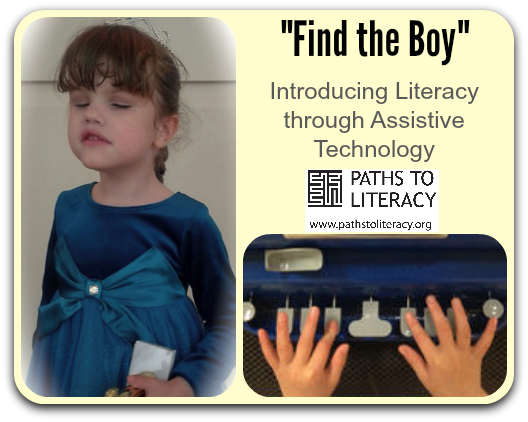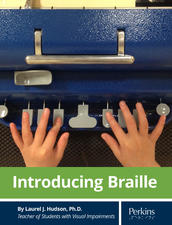Find the Boy: Video Introducing Braille Literacy through Assistive Technology
 How do we introduce braille literacy through assistive technology for young children with visual impairments? We make it fun, developmental, and meaningful, as described in the lesson segment below and paired with a short video. (Many thanks to my student’s Mom for allowing me to submit this post along with a video. We often hear the value of exposing children to technology when they are young, but we have too few examples of what this actually looks like.)
How do we introduce braille literacy through assistive technology for young children with visual impairments? We make it fun, developmental, and meaningful, as described in the lesson segment below and paired with a short video. (Many thanks to my student’s Mom for allowing me to submit this post along with a video. We often hear the value of exposing children to technology when they are young, but we have too few examples of what this actually looks like.)The Student
The Task
New Skills
-
Scrolling
She learned how to scroll forward in order to proceed through a list. (This came easily to Alex. In fact, she found great entertainment in exploring this herself by scrolling the list forward from first to last, then backward (dot 1 and the space bar) from last to first, then forward again, etc.)
-
4-Chords
Alex also learned to enter “4 chords,” pressing both dot 4 and the space bar at the same time. (This was a challenge for her, probably related to both her young age and her mild cerebral palsy. She tended to press either dot 4 or the space bar alone. In doing this, rather than giving a command to read, she was inserting miscellaneous information into the file. I didn’t think she was ready to delete these stray marks, so I kept my hand near the delete (dot 7) key in order to immediately erase them for her when they occurred.)
-
Gender and Auditory Attending
Alex progressed in learning the concept of boy/girl for familiar people in her life, and to pay attention to the note-taker’s output as she scrolled through it. (Her concept of gender was emerging. In this lesson segment, she missed “Daddy” and then guessed that the next two women’s names were boys/men. In fact, she seemed to become increasingly tentative when I didn’t accept her guesses, but then she managed to correctly skip the next three women until she reached, “Mr. Everett.” How did she achieve this? After “Daddy,” she seemed to adopt a strategy of calling everyone a man/boy, but when that didn’t work for her, she seemed to realize that she needed to focus on the content (and not just the fun voice sounds) to decide the genders by herself. I couldn’t know, at this point, if she correctly identified “Mr. Everett” as a man because of the “Mr.” after a string of “Misses” preceding his name and my references to “he” and “she,” or because she actually knew him as a man. For this early lesson, I intentionally scaffolded for success in allowing her to use either cues of knowing the people as male/female or of their “Mr./Miss” titles.
The Guidelines
In my iBook “Introducing Braille,” I recommend that early braille instruction be fun, that it be developmental, and that it be meaningful. As in this blog entry, each guideline in “Introducing Braille” is demonstrated by videotaped lesson segments. What do these guidelines look like in the “Find the Boys” lesson segment?
-
Make it Fun
Voice output was clearly fun for Alex, so I included it in most of her technology tasks. I listed people she knows because she is a very social child, and I was careful not to dampen her enthusiasm by focusing only on her errors in either forming 4-chords or in discriminating by gender.
-
Make it Developemental
To make the gender discrimination developmentally appropriate for Alex, I listed only familiar people, I added the redundant cues of “Mr.” or “Miss” and “he” and “she,” and I used only adults (whose genders are more obvious, especially to learners who are blind.) With Alex’s fine motor development in mind, I allowed Alex to read more than to write, and to practice a command that uses some of the strongest digits (index finger and thumb.)
-
Make it Meaningful
Alex already knew that she is a girl, she knew all the people named in the file, and she knew that her whole class was studying boy/man and girl/woman. She was already interested in learning gender differences and in learning whatever her typically developing peers were learning. This lesson segment made sense to her.
Read more in Teaching Braille to Young Children


